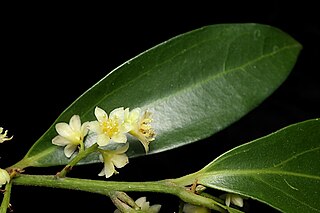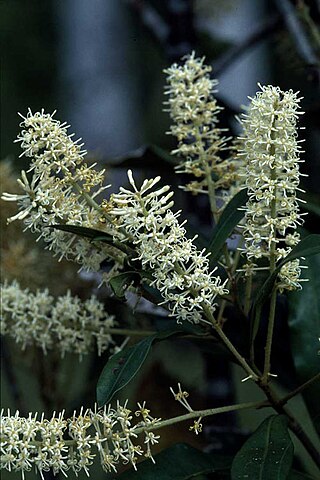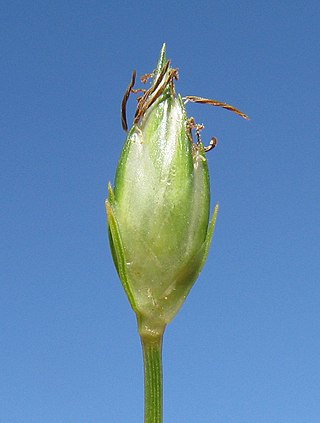
Nepenthes pilosa is a tropical pitcher plant endemic to Borneo. It is characterised by a dense indumentum of long yellow-brown hairs. Pitchers have a distinctive hook-shaped appendage on the underside of the lid. The specific epithet derives from the Latin word pilosus, meaning "hairy".

Nepenthes mollis, or the velvet pitcher-plant, is a tropical pitcher plant species natives to Kalimantan, Borneo. It used to be known only from a single dried herbarium specimen and is the sole recognised species in the genus Nepenthes of which the pitchers are unknown. In 2019 Global Wildlife Conservation announced the rediscovery of the species.

Nepenthes neoguineensis is a tropical pitcher plant native to the island of New Guinea, after which it is named.

Adansonia grandidieri is the biggest and most famous of Madagascar's six species of baobabs. It is sometimes known as Grandidier's baobab or the giant baobab. In French it is called Baobab malgache. The local name is renala or reniala. This tree is endemic to the island of Madagascar, where it is an endangered species threatened by the encroachment of agricultural land. This is the tree found at the Avenue of the Baobabs.

Normanbya is a monotypic genus of palms containing the single species Normanbya normanbyi, which is known by the common name black palm It is endemic to Queensland, Australia and is threatened by habitat destruction.
Beilschmiedia brevipes is an evergreen tree species in the family Lauraceae. It is endemic to Peninsular Malaysia, and is an endangered species.

Hedyosmum mexicanum is a species of plant in the family Chloranthaceae. It is found in Guatemala and Mexico. It is threatened by habitat loss.

Cryptocarya microneura, commonly known as murrogun, murrogun laurel or brown jack, is a species of flowering plant in the laurel family and is endemic to eastern Australia. It is a rainforest tree with lance-shaped to elliptic leaves, the flowers cream-coloured and tube-shaped but not perfumed, and the fruit a spherical to elliptic black drupe.

Cryptocarya glaucescens, commonly known as jackwood, silver sycamore, native laurel, brown beech, bolly laurel or brown laurel, is a species of flowering plant in the laurel family and is endemic to eastern Australia. Its leaves are lance-shaped to elliptic, the flowers cream-coloured or pale green, perfumed and tube-shaped, and the fruit a black drupe.

Cryptocarya obovata, commonly known as pepperberry, white walnut, long tom, she beech or purple laurel, is a species of flowering plant in the laurel family and is endemic to eastern Australia. It is a rainforest tree with oblong to egg-shaped leaves, the flowers creamy-green, tube-shaped and unpleasantly perfumed, and the fruit a spherical drupe with white or cream-coloured cotyledons.

Cryptocarya laevigata, commonly known as red-fruited laurel, glossy laurel or grey sassafras, is a species of flowering plant in the family Lauraceae and is native to Malesia, New Guinea and eastern Australia. It is a shrub or tree with lance-shaped to elliptic leaves, creamy white, pale green and perfumed flowers, and more or less spherical, red to orange-yellow drupes.

Cryptocarya triplinervis, commonly known as blackbutt, three-veined cryptocarya, brown laurel or three-veined laurel, is a species of flowering plant in the family Lauraceae and is endemic to eastern Australia. It is a tree with egg-shaped to elliptic or lance-shaped leaves, cream-coloured to pale green flowers, and elliptic black drupes.

Nothorites is a monotypic genus in the macadamia family Proteaceae. The sole species, Nothorites megacarpus, is endemic to the wet tropics rain forests of northeastern Queensland, Australia.

Atractocarpus hirtus, commonly known as the hairy gardenia or native loquat, is a plant in the coffee family Rubiaceae, a large family of some 6,500 species with a cosmopolitan distribution. This species is endemic to northeastern Queensland, Australia.

Abildgaardia ovata, synonyms including Abildgaardia monostachya and Fimbristylis ovata, is a perennial herb of the genus Abildgaardia and the family Cyperaceae. It is a widespread species that can be found in West, Southern and East Africa, Florida, Mexico, the Caribbean and in some countries of Latin America.
Dansiea elliptica is a species of rainforest tree which is endemic to Queensland, Australia. The species, which occurs within two highly disjunct centres of distribution, is primarily found in drier notophyll vine forests and semi evergreen vine thickets in the Wet Tropics of Queensland and Central Queensland. The species is listed as Near Threatened under the Queensland Nature Conservation Act (1992) and has a total area of occupancy of less than 40 square km.

Cryptocarya cunninghamii, commonly known as Cunningham's laurel or coconut laurel, is a species of flowering plant in the laurel family and is endemic to northern Australia. It is a tree with oblong to elliptic leaves, the flowers creamy-green and tube-shaped, and the fruit a spherical black to purplish-blackdrupe.

Cryptocarya anamalayana is a rare rainforest tree endemic to the southern Western Ghats, India. The specific epithet of the name refers to the Anamalai Hills, a major area of its distribution. The species considered endangered under the IUCN Red List of Threatened Species.

Cryptocarya melanocarpa is a species of flowering plant in the family Lauraceae and is endemic to north Queensland. It is a tree with elliptic to oblong to lance-shaped leaves, creamy green, unpleasantly perfumed flowers, and spherical black drupes.
Cryptocarya nitens is a species of flowering plant in the family Lauraceae and is endemic to Southeast Asia. It is a tree with elliptic to lance-shaped or egg-shaped leaves, greenish-white flowers, and shining purplish-black drupes.

















